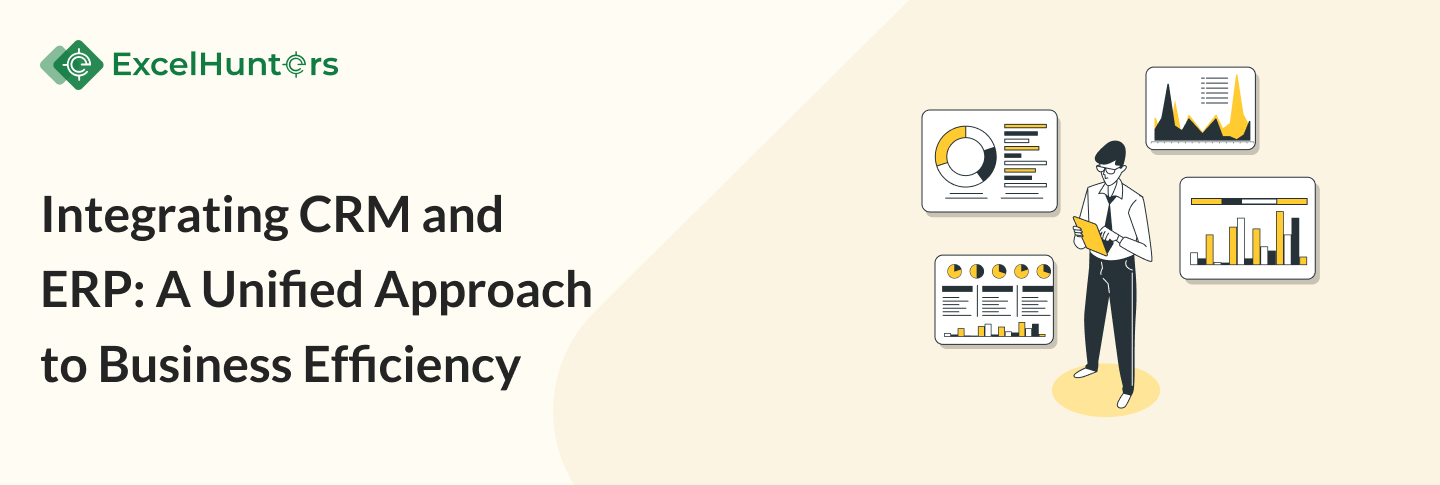Integrating CRM and ERP: A Unified Approach to Business Efficiency
Quick Summary
In today’s fast-paced business environment, ensuring efficiency and productivity is essential for long-term growth. A highly effective method to accomplish this is by combining Customer Relationship Management (CRM) and Enterprise Resource Planning (ERP) systems. This integrated strategy not only simplifies operations but also boosts data-driven decision-making, leading to better overall business performance. At Excelhunters, we recognize the significant benefits of merging these systems and are committed to assisting businesses in maximizing their potential.
What Are CRM and ERP Systems?
Customer Relationship Management (CRM) Systems
CRM systems are created to handle a company’s interactions with both current and potential customers. These platforms assist businesses in organizing customer information, tracking sales interactions, managing leads, and improving customer service.
Enterprise Resource Planning (ERP) Systems
ERP systems, on the other hand, bring together different business processes into one cohesive platform, offering a comprehensive view of operations. They handle inventory, accounting, supply chain management, human resources, and more. Some well-known ERP solutions are SAP, Oracle ERP, and Microsoft Dynamics 365.
The Importance of Integrating CRM and ERP

1. Data Synchronization and Accuracy
By integrating CRM and ERP systems, businesses ensure seamless data synchronization across departments. This integration eliminates the need for manual data entry, reducing errors and enhancing data accuracy.
2. Streamlined Operations
When CRM and ERP systems work in tandem, they streamline operations by automating workflows and bridging the gap between sales, customer service, and back-end processes such as inventory and finance.
3. Enhanced Customer Experience
A unified system provides sales and support teams with comprehensive customer insights, enabling them to deliver personalized and timely service. This can significantly boost customer satisfaction and retention.
4. Improved Decision-Making
With integrated data, businesses gain a 360-degree view of their operations, allowing for data-driven decision-making. Managers can access real-time reports and analytics, helping them identify trends, forecast demand, and optimize resources.
How CRM and ERP Integration Works
The integration process involves connecting CRM and ERP systems using middleware or APIs (Application Programming Interfaces). This enables the seamless flow of data between systems, ensuring all departments have access to the same, updated information.
1. Data Mapping and Migration
During integration, data from both systems is mapped to ensure compatibility. Existing data is then migrated to create a unified database.
2. Configuring Automated Workflows
Automation rules are established to manage data flow, triggering specific actions within each system. For example, when a sale is recorded in the CRM, inventory levels are automatically updated in the ERP.
3. Testing and Optimization
Before full deployment, testing is conducted to identify and resolve potential issues. Post-integration systems are continually optimized for performance and efficiency.
Key Benefits of Integrating CRM and ERP Systems
1. Sales and Inventory Management
An integrated system enables sales teams to access real-time inventory data, improving order processing and reducing the risk of stockouts or overstocking.
2. Financial Management and Reporting
The ERP system’s financial data, combined with CRM sales data, allows for accurate financial reporting and better management of revenue streams.
3. Enhanced Productivity
Automation of repetitive tasks, such as order processing and invoice generation, frees up employee time for more strategic initiatives.
4. Cross-Departmental Collaboration
Departments can share data seamlessly, promoting better collaboration and transparency across the organization.
Best Practices for Successful CRM and ERP Integration
1. Define Clear Objectives
Before integration, businesses should outline specific goals, such as improving sales processes or enhancing inventory management.
2. Choose Compatible Systems
Selecting CRM and ERP solutions with robust integration capabilities is essential. Ensure that both systems support APIs or have middleware that facilitates integration.
3. Focus on Data Quality
Maintaining data integrity is crucial for a successful integration. Regularly clean and update data to avoid discrepancies.
4. Train Employees
Provide training sessions to help staff understand how to utilize the integrated system effectively, maximizing productivity and adoption.
5. Monitor and Optimize
Continuously monitor the performance of the integrated system and make adjustments as needed to maintain efficiency and scalability.
Common Challenges in CRM and ERP Integration
1. Data Compatibility Issues
Incompatibility between systems can lead to data loss or corruption during integration. Address this by ensuring data is properly mapped and formatted.
2. High Implementation Costs
The integration process can be costly, particularly for small and medium-sized enterprises (SMEs). However, the long-term benefits of improved efficiency and reduced operational costs often outweigh the initial investment.
3. Resistance to Change
Employees may be hesitant to adopt a new system. Overcome this by emphasizing the benefits and providing comprehensive training.
Choosing the Right Integration Partner
Selecting an experienced integration partner like Excelhunters can make a significant difference. Our team offers:
- Customized Integration Solutions: Tailored to meet specific business needs.
- End-to-End Support: From planning and implementation to training and optimization.
- Proven Expertise: Leveraging best practices and modern technologies to ensure a smooth integration process.
Conclusion: Transforming Your Business with CRM and ERP Integration
Integrating CRM and ERP systems is a strategic move that can lead to greater efficiency, improved customer experiences, and increased profitability. By adopting a unified approach, businesses can streamline operations, enhance data accuracy, and make informed decisions that drive growth. At Excelhunters, we are committed to delivering seamless integration solutions that empower businesses to thrive in a competitive market.
Looking for
Consultations?Our Expertise
- 8 + years of experience
- Adept Developers
- Excel at Agile Development
- Cost-Effective


